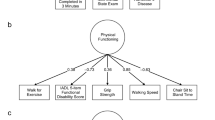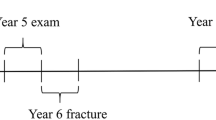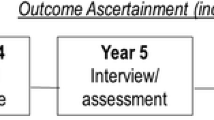Abstract
Summary
We examined the relation between a biomechanical measure, factor-of-risk, and hip fracture risk in 1,100 men and women from the Framingham Study and found that it predicted hip fracture (men, ORs of 1.8; women, 1.2–1.4).
Introduction
Alternative methods of predicting hip fracture are needed since 50% of adults who fracture do not have osteoporosis by bone mineral density (BMD) measurements. One method, factor-of-risk (Φ), computes the ratio of force on the hip in a fall to femoral strength. We examined the relation between Φ and hip fracture in 1,100 subjects from the Framingham Study with measured hip BMD, along with weight, height, and age, collected in 1988–1989.
Methods
We estimated both peak and attenuated force applied to the hip in a sideways fall from standing height, where attenuated force incorporated cushioning effects of trochanteric soft tissue. Femoral strength was estimated from femoral neck BMD, using cadaveric femoral strength data. Sex-specific, age-adjusted survival models were used to calculate hazard ratios (HR) and 95% confidence intervals for the relation between Φ peak, Φ attenuated, and their components with hip fracture.
Results
In 425 men and 675 women (mean age, 76 years), 136 hip fractures occurred over median follow-up of 11.3 years. Factor-of-risk, Φ, was associated with increased age-adjusted risk for hip fracture. One standard deviation increase in Φ peak and Φ attenuated was associated with HR of 1.88 and 1.78 in men and 1.23 and 1.41 in women, respectively. Examining components of Φ, in women, we found fall force and soft tissue thickness were predictive of hip fracture independent of femoral strength (was estimated from BMD).
Conclusions
Thus, both Φ peak and Φ attenuated predict hip fracture in men and women. These findings suggest additional studies of Φ predicting hip fracture using direct measurements of trochanteric soft tissue.
Similar content being viewed by others
Change history
01 July 2019
The original version of this article, published 23 February 2011, unfortunately contained a mistake. The following correction has therefore been made in the original:
01 July 2019
The original version of this article, published 23 February 2011, unfortunately contained a mistake. The following correction has therefore been made in the original:
References
Burge R, Dawson-Hughes B, Solomon DH, Wong JB, King A, Tosteson A (2007) Incidence and economic burden of osteoporosis-related fractures in the United States, 2005–2025. J Bone Miner Res 22:465–475
US Department of Health and Human Services (2004) Bone health and osteoporosis: a report of the surgeon general. US Department of Health and Human Services, Office of the Surgeon General, Rockville
Bouxsein ML, Szulc P, Munoz F, Thrall E, Sornay-Rendu E, Delmas PD (2007) Contribution of trochanteric soft tissues to fall force estimates, the factor of risk, and prediction of hip fracture risk. J Bone Miner Res 22:825–831
Kanis JA, Johnell O, Oden A, Johansson H, McCloskey E (2008) FRAX and the assessment of fracture probability in men and women from the UK. Osteoporos Int 19:385–397
Wainwright SA, Marshall LM, Ensrud KE et al (2005) Hip fracture in women without osteoporosis. J Clin Endocrinol Metab 90:2787–2793
Kaptoge S, Benevolenskaya LI, Bhalla AK et al (2005) Low BMD is less predictive than reported falls for future limb fractures in women across Europe: results from the European Prospective Osteoporosis Study. Bone 36:387–398
Jarvinen TL, Sievanen H, Khan KM, Heinonen A, Kannus P (2008) Shifting the focus in fracture prevention from osteoporosis to falls. BMJ 336:124–126
Keaveny TM, Bouxsein ML (2008) Theoretical implications of the biomechanical fracture threshold. J Bone Miner Res 23:1541–1547
Hayes WC (1991) Implications for assessment of fracture risk. In: Mow VC, Hayes WC (eds) Basic Orthopaedic Biomechanics. Raven, New York, pp 93–142
Bouxsein M (2007) Biomechanics of age-related fractures. In: Marcus R, Kelsey J, Rosen C, Feldman D (eds) Osteoporosis IIIe. Academic Press, Inc., San Diego, pp 601–616
Bouxsein ML, Melton LJ III, Riggs BL et al (2006) Age- and sex-specific differences in the factor of risk for vertebral fracture: a population-based study using QCT. J Bone Miner Res 21:1475–1482
Riggs BL, Melton LJ, Robb RA et al (2006) Population-based analysis of the relation of whole bone strength indices and fall-related loads to age- and sex-specific patterns of hip and wrist fractures. J Bone Miner Res 21:315–323
Melton LJ 3rd, Riggs BL, Keaveny TM et al (2007) Structural determinants of vertebral fracture risk. J Bone Miner Res 22:1885–1892
Hayes WC, Myers ER, Morris JN, Gerhart TN, Yett HS, Lipsitz LA (1993) Impact near the hip dominates fracture risk in elderly nursing home residents who fall. Calcif Tissue Int 52:192–198
Greenspan SL, Myers ER, Maitland LA, Resnick NM, Hayes WC (1994) Fall severity and bone mineral density predict hip fracture in the elderly. JAMA 271:128–133
Greenspan SL, Myers ER, Kiel DP, Parker RA, Hayes WC, Resnick NM (1998) Fall direction, bone mineral density, and function: risk factors for hip fracture in frail nursing home elderly. Am J Med 104:539–545
Nielson CM, Bouxsein ML, Freitas SS, Ensrud KE, Orwoll ES (2009) Trochanteric soft tissue thickness and hip fracture in older men. J Clin Endocrinol Metab 94:491–496
Orwoll ES, Marshall LM, Nielson CM et al (2009) Finite element analysis of the proximal femur and hip fracture risk in older men. J Bone Miner Res 24:475–483
Dawber TR, Meadors GF, Moore FE (1951) Epidemiological approaches to heart disease: the Framingham Study. Am J Pub Health 41:279–286
Hannan MT, Felson DT, Anderson JJ (1992) Bone mineral density in elderly men and women: results from the Framingham osteoporosis study. J Bone Miner Res 7:547–553
Kannel WB, Kannel C, Paffenbarger RS Jr, Cupples LA (1987) Heart rate and cardiovascular mortality: the Framingham Study. Am Heart J 113:1489–1494
Sytkowski PA, D'Agostino RB, Belanger A, Kannel WB (1996) Sex and time trends in cardiovascular disease incidence and mortality: the Framingham Heart Study, 1950–1989. Am J Epidemiol 143:338–350
Kiel DP, Felson DT, Anderson JJ, Wilson PW, Moskowitz MA (1987) Hip fracture and the use of estrogens in postmenopausal women. The Framingham Study. N Engl J Med 317:1169–1174
van den Kroonenberg AJ, Hayes WC, McMahon TA (1996) Hip impact velocities and body configurations for voluntary falls from standing height. J Biomech 29:807–811
Robinovitch SN, Hayes WC, McMahon TA (1991) Prediction of femoral impact forces in falls on the hip. J Biomech Eng 113:366–374
Robinovitch SN, McMahon TA, Hayes WC (1995) Force attenuation in trochanteric soft tissues during impact from a fall. J Orthop Res 13:956–962
Roberts BJ, Thrall E, Muller JA, Bouxsein ML (2010) Comparison of hip fracture risk prediction by femoral aBMD to experimentally measured factor of risk. Bone 46:742–746
Maitland LA, Myers ER, Hipp JA, Hayes WC, Greenspan SL (1993) Read my hips: measuring trochanteric soft tissue thickness. Calcif Tissue Int 52:85–89
Beck TJ, Ruff CB, Warden KE, Scott WW Jr, Rao GU (1990) Predicting femoral neck strength from bone mineral data. A structural approach. Invest Radiol 25:6–18
Cheng XG, Lowet G, Boonen S et al (1997) Assessment of the strength of proximal femur in vitro: relationship to femoral bone mineral density and femoral geometry. Bone 20:213–218
Cheng XG, Lowet G, Boonen S, Nicholson PH, Van der Perre G, Dequeker J (1998) Prediction of vertebral and femoral strength in vitro by bone mineral density measured at different skeletal sites. J Bone Miner Res 13:1439–1443
Bouxsein ML, Coan BS, Lee SC (1999) Prediction of the strength of the elderly proximal femur by bone mineral density and quantitative ultrasound measurements of the heel and tibia. Bone 25:49–54
Keaveny TM (2010) Biomechanical computed tomography-noninvasive bone strength analysis using clinical computed tomography scans. Ann NY Acad Sci 1192:57–65
Acknowledgments
We acknowledge grant funding for this project was provided by the American College of Rheumatology Research and Education Foundation’s Abbott Health Professional Graduate Student Research Preceptorship; the National Institute of Arthritis and Musculoskeletal and Skin Diseases and the National Institute on Aging (R01-AR/AG 41398 and AR053986); and by the National Heart, Lung, and Blood Institute’s Framingham Heart Study (N01-HC-25195).
Conflicts of interest
Dr. Douglas P. Kiel is involved in research grants from Novartis, Merck, Amgen, Pfizer, and Hologic, and consulting for GlaxoSmithKline, Merck, Novartis, Amgen, Eli Lilly, Procter & Gamble, Wyeth, and Sanofi Aventis. All other authors have no relevant conflicts of interest.
Author information
Authors and Affiliations
Corresponding author
Additional information
An erratum to this article is available at http://dx.doi.org/10.1007/s00198-014-2686-5.
Rights and permissions
About this article
Cite this article
Dufour, A.B., Roberts, B., Broe, K.E. et al. The factor-of-risk biomechanical approach predicts hip fracture in men and women: the Framingham Study. Osteoporos Int 23, 513–520 (2012). https://doi.org/10.1007/s00198-011-1569-2
Received:
Accepted:
Published:
Issue Date:
DOI: https://doi.org/10.1007/s00198-011-1569-2




